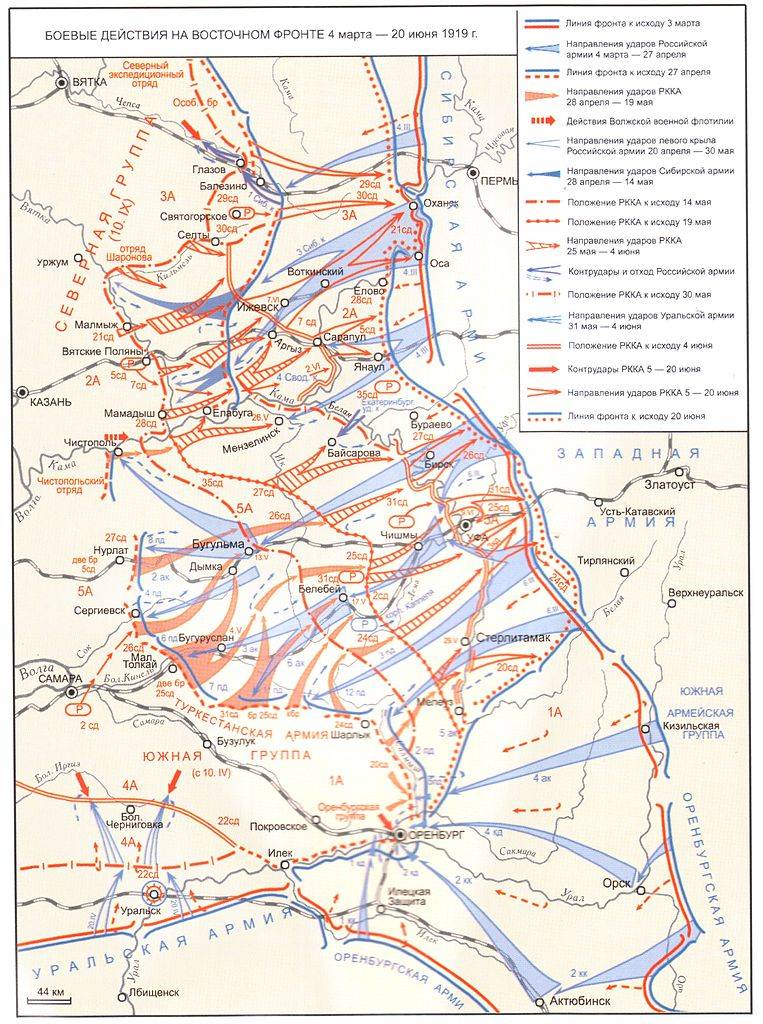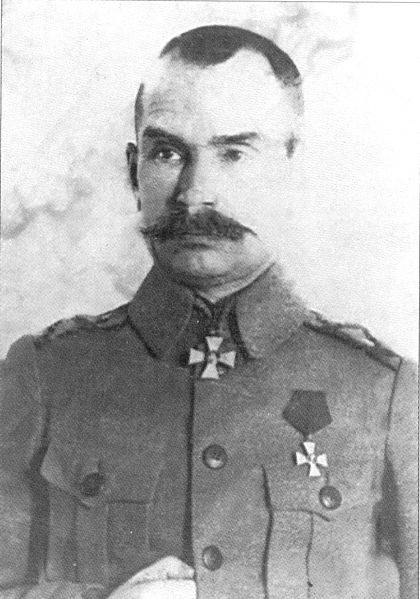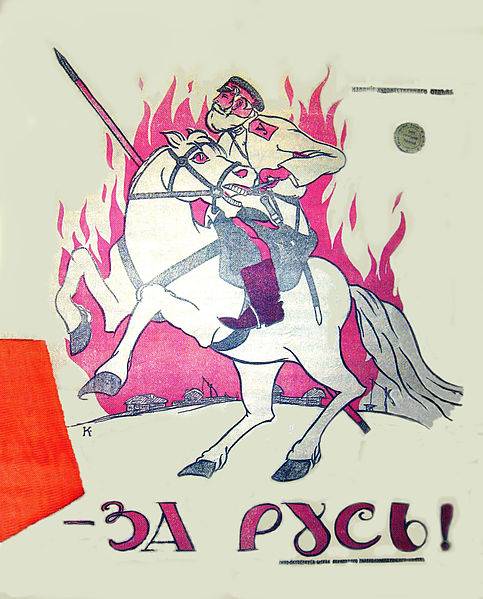How Kolchak's army broke through to the Volga
The onset of the army of Kolchak
In February 1919, the Russian army under the command of Kolchak number of private operations could prepare a favorable starting position for the transition into a general offensive. So, the White Guards attacked the 2 of the Red Army and pressed its right flank towards Sarapul. This led to the withdrawal of the 2 Army to the Kama line. As a result, the left flank of the 5 Red Army in the Ufa area was open, and the right flank of the 3 Red Army retreated to the Okhansk.
Siberian Army. 4 March 1919, the Siberian army under the command of General Gaida launched a decisive offensive, striking the main blow between the cities of Okhansk and Osa, at the junction of the 3 and 2 of the Red armies. The 1 of the Central Siberian Corps Pepeliaev forced the Kama across the ice between the towns of Osa and Okhansky, while the 3 of the West Siberian Verzhbitsky Corps advanced to the south. 7 - 8 March White took the city Wasp and Okhansk, and continued to move along the line p. Kamy.
Siberian Army to develop the offensive, occupied large areas. However, its further movement was slow due to the enormity of space, poorly developed communications of the theater of military operations, the beginning of the spring thaw and increased resistance to the Red Army. 2-I red army suffered heavy losses, but retained combat capability, the breakthrough of the red front failed. After the work of the "Commission of Stalin - Dzerzhinsky," which investigated the causes of the so-called. The “Perm catastrophe”, the quantitative and qualitative reinforcement of the Red armies, the Reds were no longer what they were in December 1918. Retreating, they fought, preserved the combat effectiveness and integrity of the front.
In April 1919, the Whites established themselves again in the Izhevsk-Votkinsk region: on April 8 the Votkinsk plant was captured, on April 9 - Sarapul, and on April 13 - the Izhevsk factory. Kolchakites broke through in the direction of Yelabuga and Mamadysh. At the mouth of the Kama was directed white flotilla with the landing. Then White developed an offensive in the direction of Vyatka and Kotlas. However, the front of the red armies Kolchakites could not break through. On April 15, the extreme right-flank units of the Haida army entered the completely off-road and wild Pechora region in contact with small groups of the Northern White Front. However, this event, as previously noted, did not have any serious strategic consequences. The weak Northern Front could not provide any significant assistance to the Russian army of Kolchak. This was originally connected with the position of the Entente, which was not going to fight with Soviet Russia in full force.
In the second half of April Siberian Army still advancing. But its onslaught has weakened due to the increased resistance of the 3 th Red Army. The left flank of the army pushed Gajda right wing 2-th Red Army of the lower reaches of the river. Vyatki. A serious factor was the spring thaw, the lack of a developed network of roads, a huge territory. White corps were separated, lost contact with each other, could not coordinate their actions. Communications were greatly stretched, the advanced units lost the supply of ammunition, food, artillery stuck. The troops were overworked preceding jerk, it was not operational and strategic reserves, which develop early successes. Personnel hunger declared itself, officers died, there was no one to replace them. Replenishment, mainly of the peasants, had low combat capability, did not want to fight for the masters.

Western army. Western Army under the Khanzhin March 6 1919 year launched an offensive in the general direction of Ufa, Samara and Kazan. Mikhail Khanzhin participated in the war with Japan, during the First World War he commanded an artillery brigade, an infantry division, and was an inspector of artillery of the 8 Army. He played a prominent role in the Lutsk (Brusilovsky) breakthrough and he was promoted to lieutenant general. Then the inspector of artillery of the Romanian front, the inspector general of artillery under the commander-in-chief. Khanzhin proved to be a talented artillery commander and a combined-arms commander.
The Khanzhin army offensive was more active and had serious results than the movement of the Siberian army. The strike force of the whites (Wojciechowski’s 2 Corps and the Golitsyn Urals Corps) attacked the junction between the inner flanks of the 3 and 5 Red armies, where there was an almost empty gap in 2 - 50 kilometers. This largely predetermined the continued success of Kolchak's army in the Spring Offensive.

Commander of the Western Army, Mikhail Vasilyevich Khanzhin
White hit the left flank 5-th Red Army (the left flank brigade 27-th Infantry Division), broke and threw red. White Guards, sharp bends to the south, along the highway traffic Birsk - Ufa became almost with impunity to cut the rear stretched both 5-divisions of the Red Army (27-rd and 26-th). The commander of the 5 Army Blumberg attempted to throw his divisions to a counterattack, but they were defeated by superior enemy forces. As a result, 4-5-day Battle Army was broken, the interaction of its troops violated, remnants of the army, divided into two groups, tried to cover two major areas - Menzelinsky and Bugulma.
On March 10, which broke through the front of the Red Army, the 2 Ufa Corps of Wojciechowski took Birsk on the run. Kolchak moved in a southerly direction, bypassing Ufa from the west. For several days they moved with impunity in the rear of the 5 st Red Army, crushing them. At the same time, the 6 th Ural Corps of General Sukin launched a frontal attack on the Ufa area. March 13 Corps General Golitsyn took Ufa, the Reds fled to the west, south of the railway Ufa - Samara. White could not surround them, however, they captured rich trophies, a lot of supplies and military equipment. 5-I army retreated, suffering heavy casualties by prisoners and fled. Many themselves surrendered to captivity and went over to the side of whites. 22 in March, whites took Menzelinsk, but then they left him and occupied 5 for the second time in April.
The Red Command, from 13 to the end of March, tried to rectify the situation by putting in reserves and separate units in the 5 Army sector, as well as concentrating and vigorous actions of the group on the left side of the 1 Army in the Sterlitamak region. This group launched an offensive on Ufa from the south. However, the situation could not be restored. March 18 on the left flank launched an offensive of the Southern Group of the Western Army and the troops of the Separate Orenburg Army Dutov. The fight in 35 kilometers south of Ufa was stubborn: the settlements changed hands several times. The outcome of the battle predetermined the transition to the side of the white Bashkir red cavalry regiment and the arrival of the Izhevsk brigade to this section. By April 2 the Reds retreated, April 5 took White Sterlitamak and launched an offensive against Orenburg.
The offensive in the central direction continued to develop successfully. April 7 Kolchak took Belebey, April 13 - Bugulma, April 15 - Buguruslan. On April 21, parts of Khanzhin came out to Kama, creating a threat to Chistopol. Soon they took it and created a threat to Kazan.
In the southern direction, the Orenburg Cossacks of 10 of April took Orsk, and the Ural Cossacks of General Tolstov of 17 of April occupied Lbishchensk and besieged Uralsk. Cossacks Dutov came to Orenburg, but got bogged down here. Cossacks and Bashkirs, mostly cavalry, failed to take a well-fortified city. And the Ural Cossacks got bogged down at its capital of ours, Uralsk. As a result, the selected Cossack cavalry, instead of going into the opening gap in the center, in the raid along the red rear, got stuck in Uralsk and Orenburg.
Thus, the Western Army Khanzhin carried out a strategic breakthrough of the center of the Eastern Red Front. And if this event did not cause the collapse of the entire Eastern Front of the Red Army and, accordingly, the catastrophic situation in the eastern direction, this was due primarily to the peculiarity of the civil war. The vast expanses of Russia were absorbed by the troops and both sides were maneuvering military operations by small detachments. The western army, as it moved forward, increasingly stretched its front. Having occupied 15 on April in Buguruslan, the army of Khanzhin stretched out already at the front in 250 – 300 km, having its right flank at the mouth of the r. Vyatka, and left - southeast of Buguruslan. On this front, five infantry divisions were fanned. Their striking power was falling all the time, and there were very few second-tier troops and strategic reserves. Whites made a deep breakthrough, but this did not affect or had little effect on the neighboring groups of troops. White had to put the troops in order, regroup them, tighten the rear, which gave time for red to gain time, to tighten new forces, reserves, to start a counter-maneuver.
In addition, the White Command did not abandon the idea of connecting with the Northern Front. At the time of the breakthrough of the Western army in the center, it would be reasonable to strengthen Khanzhin at the expense of the Siberian army. But they did not. And the Cossack army - Orenburg and Ural, stuck in the south.

White propaganda poster "For Russia!" With the image of the Ural Cossack. White Eastern Front. 1919 year
Red actions
The Supreme Red Command took emergency measures to rectify the situation in the east of the country. A wave of recruits from politically active, conscientious fighters, from trade union members and volunteer workers was sent to the Eastern Front. The strategic reserve of the main command was also thrown in there - the 2-rifle division, two rifle brigades (10-th rifle division from Vyatka and 4-rifle division from Bryansk) and 22 ths. Also at the disposal of the Eastern Front was the 35-I Infantry Division, which was formed in Kazan. The 5 division from the Vyatka direction also pulled here.
This allowed by mid-April 1919 to begin changing the balance of forces on the Eastern Front in favor of the Red Army. So, on the Perm and Sarapul directions against 37 thousand of fighters of the Red Army acted 33 thousand of whites. In the central direction, in the area of the front breakthrough, whites still had a significant advantage - 40 thousand soldiers against 24 thousand red troops. That is, the numerical inequality in forces was significantly reduced, instead of quadruple (more than 40 thousand against 10 thousand), which was at the beginning of the operation, decreased to almost double.
In the same period, the commander of the Southern Red Army Group (1, Turkestan and 4) Frunze carried out a number of regrouping of troops in order to strengthen their own position, create a reserve, strengthen the center of the Eastern Front, where the situation developed under the catastrophic scenario and prepare a counterattack of the Southern Group . As a result, the active actions of Frunze became prerequisites for the future successful counter-offensive of the Red Army. The 4 Army was weakened by the withdrawal of the 25 Rifle Division (first to the army group reserve), but received only a defensive mission. The Turkestan army was supposed to keep the Orenburg region and maintain contact with Turkestan, therefore it was reinforced by one brigade of the 25 division. The other two brigades of the 25 Division were transferred to Samara, the junction of the routes to Ufa and Orenburg, strengthening the Ufa-Samara sector. In the future, the 4 and Turkestan armies were supposed to restrain the attacks of the Orenburg and Ural armies of the enemy.
The difficult situation was on the site 1 th Red Army. Her right wing (24-Infantry Division) in early April, developed a successful attack on the Trinity. And the left wing sent three regiments to the Sterlitamak area and a brigade on Belebey to help the 5 Army. However, the enemy defeated a group of red troops in the Sterlitamak area, took it, and also prevented the brigade moved to Belebey, seizing it. The left flank of the 1 Army was weakened, and the fall of Belebey created a threat to the rear of the 1 Red Army. I had to stop the successfully developing offensive of the right flank of the 1 Army and quickly withdraw the 24 Division. While the remnants of the broken 20 th infantry division were holding back the enemy in the Belebei direction, the 24 th division was transferred to the area by forced marches. Departure 1-th army forced the Turkestan army also perform a partial regrouping ago and to 18 - 20 April its new front passed through Aktyubinsk - Elias - Exaltation of the Cross. And Frunze strengthened the position of his two armies by advancing a strategic reserve in the Orenburg-Buzuluk area.
Thus, Frunze began preparing and accumulating reserves for the future counter-offensive of the Red Army on the Eastern Front. 7 April the Eastern Front Command 1 outlined concentration-th Army near Buzuluk, Sharlyk to apply flanking counterattack on the enemy that Buguruslan and Samara. On April 9, the Eastern Front RVS expanded the operational capabilities of the Southern Group, including the 5 Army in its structure and giving Frunze complete freedom of action. The commander of the Southern Group had to regroup the troops and deliver a decisive blow to Kolchak's army before the end of the spring thaw or after it. On April 10, the Eastern Front RVS directive was issued, on which the Southern group was to strike at the north and defeat the enemy, who continued to push the 5 Red Army. At the same time, the Northern Group of Forces was formed as part of the 2 and 3 armies under the command of the 2 army commander Shorin. She was assigned the task of defeating the Siberian Army of Gaida. The boundary line between the North and South groups passed through the Birsk and Chistopol, the mouth of the Kama.
Results
As a result of the spring offensive Russian Army Kolchak White broke through the Red East Front in the center (position 5-Army), defeated the northern flank of the Eastern Front of red (severe loss of 2-th Red Army); occupied vast territories, including the Izhevsk-Votkinsk district, Ufa and Bugulma, reached the approaches to Vyatka, Kazan, Samara, Orenburg. Kolchakians captured a vast region with a population of more than 5 million.
The Soviet high command had to take emergency measures to stabilize the situation in the east of the country and organize a counter-offensive. “Flight to the Volga” (“Run to the Volga”) of Kolchak’s Russian army eased the position of Denikin’s army in the South of Russia (VSYUR). The strategic reserves of the Red Army were transferred to the Eastern Front, as well as the main replenishment, which helped Denikinians to win in the South of Russia and begin the march on Moscow.
In the military-strategic sense, it is worth noting the successful choice of the strike site - the junction of the 2 and 5 of the Red armies, which was practically naked. White also took advantage of the weakness of the 5 army - creating a quadruple superiority in the direction of the main attack. However, the White Command made a strategic mistake, inflicting two main blows - the Perm-Vyatka and Ufa-Samara sectors. In addition, in the future, two shock fists even more sprayed their forces, advancing in several directions at once. Corps and divisions lost contact, could not already establish interaction. As far as moving forward, the vast spaces of Russia simply swallowed the white army, it lost its shock power. The backbone of the army was thawing, Kolchak’s army was struck by personnel shortages, and new peasant reinforcements constantly worsened the fighting qualities of the Russian army. At the same time, the strength and resistance of the Reds grew. In its ranks there was a talented, tough and clever commander, a brilliant commander Frunze, he was able to regroup the forces of the Southern Army Group, began preparing a counterattack. In addition, do not forget the natural conditions - the period of spring thaw, which significantly impaired the ability to move.

Kolchak during a trip to the front with the son of the regiment. 1919
Information